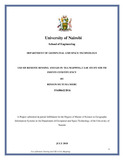| dc.description.abstract | The main aim of this research is to map tea plantations within three tea processing factories (Kionyo, Kinoro, Imenti) in South Imenti Constituency. Further analysis is done to evaluate the number of tea bushes and tea fertilizer needed in these plantation and compare this data with the factories data to check if they correspond.
The process involves processing remotely sensed imagery from Landsat 8 OLI & TIRS using Environment for Visualizing Images (ENVI 5.3) through Supervised Classification and testing Parallelepiped Classifier, Minimum-Distance to the Mean Classifier, Gaussian Maximum Likelihood Classifier for best final results. Also, ground truth data was collected and used as image training data and as ground truthing data.
The results of this study showed that Maximum Likelihood Classifier is the best method for use in mapping tea plantation and vegetation cover at large. This method displayed that, in South Imenti Constituency there are 5,051.61 hectares of land under tea bushes. These hectares translate to 54,557,388 total tea bushes if a standard spacing of 1.2m by 0.75m is used and total of 77,940 tea fertilizer bags calculated from recommended fertilizer application of 700 tea plants per bag of 50 Kgs.
From this study it is concluded that, using Remote sensing and satellite imagery is a faster and less costly method and one can map tea plantations and estimate tea bushes and fertilizer need under uniform tea spacing. | en_US |

